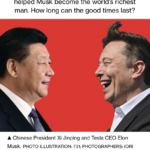 Tesla’s unprecedented success in China has helped Musk become the world’s richest man. How long can the good times last?
Tesla’s unprecedented success in China has helped Musk become the world’s richest man. How long can the good times last?
- 2021.04, Auto Shanghai, breaks don’t work
Bloomberg Businessweek By Matthew Campbell, with Chunying Zhang, Haze Fan, David Stringer, and Emma O’Brien, 2021.1.13
Last Feb. 10, as authorities in China ended work stoppages intended to halt the novel coronavirus, much of the country remained quiet. Transportation was still disrupted, and many workers were stuck in their home provinces. Others had been told to avoid their factories and offices until managers formulated plans to reopen safely.
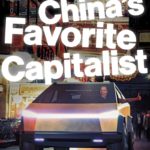 But on a marshy plain on the outskirts of China’s largest city, Tesla Inc.’s Giga Shanghai was bustling. Thousands of laborers were back on the assembly line, many of them brought in on government-provided buses from dormitories secured by officials to keep them from mingling with the community. The workers had plenty of N95 masks: Unlike many businesses, Tesla had been allocated ample shipments by the bureaucrats who’d assumed control of protective gear supplies. The factory was being cleaned with a disinfectant that required a regulator’s license to purchase, too.
But on a marshy plain on the outskirts of China’s largest city, Tesla Inc.’s Giga Shanghai was bustling. Thousands of laborers were back on the assembly line, many of them brought in on government-provided buses from dormitories secured by officials to keep them from mingling with the community. The workers had plenty of N95 masks: Unlike many businesses, Tesla had been allocated ample shipments by the bureaucrats who’d assumed control of protective gear supplies. The factory was being cleaned with a disinfectant that required a regulator’s license to purchase, too.
In its first week after resuming production, with Toyota Motor Corp., Volkswagen AG, and other foreign carmakers still unable to fully reopen, Tesla Shanghai made about 1,000 cars. By March it was up to 3,000 a week, a higher rate than before the shutdown. Around that time, according to people familiar with the conversation, an executive remarked in an internal discussion that Tesla didn’t just have a green light from the government to get back to work—it had a flashing-sirens police escort. (In an email, a company representative said that “no Tesla executive has ever made such a statement.”)
Tesla’s rapid return to normal was consistent with the relationship the electric vehicle maker has enjoyed with the Chinese state since 2018, when it announced plans to build the Shanghai plant. Again and again, it has extracted perks other international companies have struggled to obtain, including tax breaks, cheap loans, permission to wholly own its domestic operations, and assistance constructing a vast facility at astonishing speed. Support from the government has helped Tesla turn China into its most important market outside the U.S. The Model 3 is now among the bestselling EVs in the world’s most populous country, and in Tesla’s most recent earnings report, China accounted for about a fifth of revenue—a performance that helped make Elon Musk the world’s richest man this month. Perhaps most crucially, the company is moving closer to the heart of the frenetic Chinese technology sector than almost any foreign rival. Tesla China is more than a branch plant; it’s intended to do original research and development work, allowing it to hire some of the country’s brightest technical minds and keep them away from potential competitors.
In turn, Tesla and its chief executive officer have done all the right things as far as Beijing is concerned. Musk, who didn’t respond to requests to be interviewed for this story, has effusively endorsed China’s talent pool and its ambitious plans for EVs, remarks that go a long way in a country whose leaders are intensely sensitive to foreign judgments. Tesla’s local unit has also aligned itself explicitly with President Xi Jinping’s economic policy goals and forced China’s vast array of EV manufacturers to up their game, a crucial step in the government’s efforts to dominate the age of electric mobility.
As Tesla’s presence has grown, it’s been fair to wonder if Musk has become Xi’s favorite foreign capitalist. But though Musk’s is a privileged position, it’s also an awkward one. U.S.-China relations are at their lowest point since at least the early 1990s, a trend intensified by President Trump but almost certain to continue beyond his term, with President-elect Joe Biden increasingly skeptical of China and hawkish attitudes commonplace among legislators from both parties. Stung by years of protectionism and intellectual-property theft, and mindful that China has been accused of large-scale human rights abuses in Xinjiang and Hong Kong, few American CEOs are willing to publicly praise it anymore. Even fewer would say, as Musk did on a podcast over the summer, that “China rocks.”
So far, Musk’s dealings there have done little to undermine his position at home. Beloved by many liberals for his environmental credentials, hailed by Trump-aligned conservatives for his efforts to restore U.S. manufacturing, and—through SpaceX—trusted by the Pentagon to launch spy satellites, he seems as popular in Washington as he is in Beijing. But as relations between the two capitals deteriorate and an increasingly authoritarian China seeks to seize global leadership in key technologies such as EVs and artificial intelligence, it’s not clear how long Musk will be able to straddle this geopolitical fault line. U.S. politicians could decide they don’t want one of the country’s flagship industrial companies sharing knowledge with a strategic rival; Chinese leaders could adopt a less indulgent view of Tesla once it has served their purposes.
Under Xi’s economic strategy, “foreign companies are going to have pretty good opportunities, but they have to be aware that the ultimate plan is for all the advanced technologies to be Chinese,” says James McGregor, the chairman for Greater China at government relations firm Apco Worldwide. “I hope that Elon is going in there with both eyes open.”
 Tesla’s Shanghai Gigafactory. Photo: Costfoto/Barcroft Media/Getty Images
Tesla’s Shanghai Gigafactory. Photo: Costfoto/Barcroft Media/Getty Images
China is the world’s largest market for EVs by a huge margin, with about 1.2 million sold in 2020, more than 40% of the global total. To a large extent, their popularity is driven by government policy. For a decade, central and local administrations have offered a complex mix of subsidies and incentives for buying plug-in hybrid or fully electric cars. Some big cities have also implemented systems that penalize owners of conventional vehicles. In Shanghai, for example, license plates for new gasoline-powered cars have to be purchased in an auction, at prices that are currently around $14,000, whereas plates for EVs are free.
Yet even in the most plugged-in cities, Teslas were rare until fairly recently. In 2015 the company sold about 3,700 cars in China, compared with almost 33,000 by then-leader Zhidou Auto, a maker of golf-cart-size electric hatchbacks. There were some costly early mistakes. When Tesla began selling its first sedan, the Model S, in China in 2014, its designers hadn’t grasped that Chinese buyers wealthy enough to afford one tended to have chauffeurs and so wanted fancier backseats. Its software suite was also missing some popular Chinese apps, and its cars’ charging ports were compatible only with Tesla’s proprietary chargers, not China’s national standard.
The bigger problem was that every Tesla sold in Beijing or Shanghai was made in the U.S. Like many Chinese government initiatives, EV subsidies had been designed to expand the country’s industrial base and support state companies, so they generally didn’t apply to imported vehicles. Chinese manufacturers such as BYD Auto Co. and BAIC Group, by contrast, benefited enormously from the aid, which allowed them to sell midrange EVs for the equivalent of $20,000 or less after purchase subsidies.
Within Tesla, discussions about China proceeded warily. Three former senior managers, who asked not to be identified describing internal deliberations, recall intense scrutiny of dealings with Chinese suppliers or partners, in part over concerns about protecting intellectual property. The integrity of supply chains was another worry. Tesla executives, two of the managers say, often didn’t feel they knew enough about the environmental records of some Chinese vendors—for example when it came to graphite, a critical battery component whose mining can cause severe pollution.
In 2017 the company’s orientation to China began to change. That March, Tencent Holdings Ltd., a flagship tech business with close connections to the state, bought a 5% stake in Tesla, prompting Musk to declare on Twitter that it would be “an investor and advisor.” He didn’t specify on what Tencent would advise, but the deal seemed to presage a serious push into China. Tesla was also working to correct some of its earlier issues, by adding, for example, Chinese-standard charging ports.
Out of public view, Tesla was exploring how it could build a more robust presence there, with executives canvassing mainland cities in search of potential factory sites. Shanghai, traditionally China’s most outward-looking metropolis and the hometown of Robin Ren, the Stanford-trained engineer who headed Tesla’s Asia-Pacific operations, was an obvious front-runner. But Chinese cities have a long history of competing to attract big-name foreign investors, and in the U.S., Musk had proved adept at making governments vie for his affections, securing generous incentives and tax breaks for a factory near Reno, Nev., and a rocket launch site in South Texas. In its discussions with potential Chinese hosts, according to people familiar with the search, Tesla had a nonnegotiable condition: 100% control of its local operations, to protect its IP and arguably the world’s hottest automotive brand. No other entity, Chinese or otherwise, could take even a small financial stake.
This was a very big ask. Since the 1990s, China had barred foreign car companies from setting up wholly owned units. Instead they had to enter 50-50 joint ventures with Chinese entities, sharing revenue, technology, and expertise with companies that might use those assets to develop competing products. Changing the rules would require both local and national government support. By late 2017, Tesla had settled on Shanghai as the likely choice for a factory, but people familiar with the matter told Bloomberg News early the next year that negotiations were stalled over the ownership question, with central government officials insisting on a JV.
Musk’s timing proved fortuitous, though. The U.S.-China trade war was intensifying, with Trump threatening wide-ranging tariffs and American companies encountering a more hostile environment in the People’s Republic, including calls on social media to boycott their products. In a survey of member businesses published in 2018, the American Chamber of Commerce in China reported that 75% felt “less welcome than before,” reflecting “perceptions among foreign-invested companies that they are not treated equally.” For the first time since China’s economic opening in the 1980s, it seemed possible that the inward flow of foreign money and expertise would reverse course, jeopardizing growth. “China was looking for headlines to say that U.S. companies still want to come here,” says Kenneth Jarrett, a former U.S. consul general in Shanghai and now a senior adviser at the Albright Stonebridge Group. “And Tesla realized that and realized that they could bargain harder and win.”
Musk held out for full control, and in April 2018 he got it. That month the powerful National Development and Reform Commission announced that the 50% foreign ownership cap for automotive businesses would disappear by 2022, with operations devoted entirely to EVs exempted almost immediately. Three months later Tesla sealed an agreement with the Shanghai government for a factory capable of producing 500,000 vehicles a year.
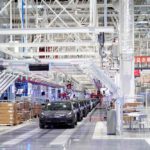 China-made Model 3s during a delivery event at Tesla’s Shanghai factory last year. Photographer: Aly Song/Reuters
China-made Model 3s during a delivery event at Tesla’s Shanghai factory last year. Photographer: Aly Song/Reuters
Early in 2019, Musk and a host of dignitaries gathered by a muddy field in the Lingang New Area, a development zone an hour and a half’s drive from the center of Shanghai. Taking the stage behind a white, Tesla-branded lectern, he marked the occasion with characteristic hyperbole. The factory the company was breaking ground on, he said, would be “perhaps the most advanced” on the planet. What was more, “we think, with the resources here, that we can build the Shanghai Gigafactory in record time.”
He then went to Beijing, his every move tracked on social media by Chinese fans, many of whom were charmed by his decision to dine at one of the city’s better-known hot pot restaurants. The highlight of the trip was an audience with Premier Li Keqiang. “I love China,” Musk said as they met, providing a soundbite that would be distributed enthusiastically by state media. It quickly became clear that China loved him back, and not only because Li replied that Musk might be granted permanent residence.
In March of that year, several state-backed banks finalized a deal with Tesla for as much as $521 million in construction financing. They agreed to lend the money at a subsidized rate and on a nonrecourse basis, meaning that in the event of default, the banks would have no legal claim on Tesla beyond its collateral. The factory was already going up at an astonishing pace, with the Shanghai government prodding it on any way it could. Tesla had been allowed to begin work before securing all its permits, and local officials were stationed on site to process paperwork. Connecting the facility to the water network took only four days, and State Grid, the national electricity distributor, said it had completed Tesla’s power hookup faster than for any project of comparable size.
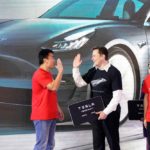 Musk greeting Model 3 vehicle owners in Shanghai. Photographer: Aly Song/Reuters
Musk greeting Model 3 vehicle owners in Shanghai. Photographer: Aly Song/Reuters
Tesla seemed as popular in Beijing, where Musk returned in August 2019 for a schedule of meetings that included a sit-down with the minister of transport, Li Xiaopeng. The same day, the government announced that all Teslas, no matter where they were made, would henceforth be exempt from a 10% purchase tax on new vehicles. The carve-out brought the number of carmakers receiving the exemption, intended to encourage the adoption of EVs, to 33. The other 32 were foreign-domestic joint ventures or wholly Chinese.
Then again, Tesla’s local operation was beginning to look like a domestic entity. In mid-2019 the company had begun an overhaul of its Chinese business, previously part of an operating unit for the Asia-Pacific region. Now, Tesla China would be an independent division reporting directly to the U.S. headquarters. Tom Zhu, a Chinese-born executive who’d been overseeing construction in Shanghai, was put in charge, and he set about making the unit more autonomous and distinct from the rest of Tesla.
Soon after he took over, according to current and former employees who asked not to be identified discussing internal matters, Zhu told staff to start writing emails in Chinese whenever possible. Most departments were directed to report only to him, the employees say, and direct contact with the U.S. was sharply limited—so much so that sending a direct message without Zhu’s approval to Musk, who’s long invited even low-level staff to bring problems straight to him, could draw a reprimand. (The Tesla representative said there are “no measures blocking connections” between China and headquarters.)
The reorganization also increased the power of Grace Tao, a former correspondent for state-controlled China Central Television who leads communications and government affairs. Tao made little secret, the employees say, that her priority was to ensure Tesla retained support from the top echelon of the Chinese state. She hung a large organizational chart depicting the upper reaches of the central government and senior officials in key provinces—critical Kremlinology in modern China. According to the employees, she’s said that if she wants to get a message to Xi, she need only go through one intermediary, which would be an astronomical level of access in China. (The Tesla representative denied that Tao has ever made this claim.)
As Tesla’s plans for production in Shanghai advanced, the help kept coming. In early December 2019, China-made Model 3s were approved for purchase subsidies of just under 25,000 yuan ($3,900) per vehicle, despite a broad government effort to curtail such giveaways as EVs became more competitive with conventional cars. Shortly afterward, Tesla secured another financing deal from state-controlled banks, this time worth more than $1 billion.
Musk’s claim that the Shanghai factory would be up and running with unprecedented speed proved correct. Its cars began rolling off the line right before the end of 2019, less than a year after groundbreaking. In keeping with company practice, the first vehicles were reserved for employees, one of whom, as the launch event unfolded, proposed to his girlfriend with the car as an engagement gift. She said yes.
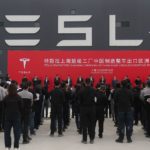 A ceremony to celebrate the shipment of China-built Model 3s to Europe in October. Photographer: Ding Ting/Xinhua/Getty
A ceremony to celebrate the shipment of China-built Model 3s to Europe in October. Photographer: Ding Ting/Xinhua/Getty
So far, Chinese consumers—who, because of the near-elimination of the coronavirus within their borders, are closer to economic normalcy than the citizens of virtually any other major country—have reacted enthusiastically to Tesla’s expanded presence. The Model 3 was China’s most popular EV for much of 2020, and the Shanghai plant has also begun producing the Model Y sport utility vehicle. In October the city’s government delivered yet another blow to traditional cars, declaring that vehicles with out-of-town registrations would be barred from key downtown roads during the daytime, an effort to tame resurgent traffic snarls. That prompted more demand for EVs among commuters seeking to capitalize on the vehicles’ exemption from the auction system for new Shanghai plates. Potential buyers were particularly interested in Teslas, thronging local dealerships in maskless, undistanced crowds.
Already, the Chinese market has become crucial to Tesla’s overall business. The company recently changed how it reports financial figures to make China the only country, aside from the U.S., for which it breaks out quarterly revenue. It rose there from $669 million in the third quarter of 2019 to $1.74 billion in the same period of 2020. Musk’s bet, in other words, is paying off.
The question of what China is gaining is more complicated. For many automotive experts, the government’s prime motive is clear: to upgrade the capabilities of the Chinese electric car industry by forcing Tesla’s competitors and suppliers to improve their game. Beijing in recent years has been gradually withdrawing support for EV companies, seeking to consolidate an industry that at one point had almost 500 domestic players. Tesla, the theory goes, will be the stick against which the remaining players measure themselves. It will also provide a major boost to companies such as Contemporary Amperex Technology Co., the Chinese battery giant providing power packs for some of Tesla’s Shanghai-made cars. Thanks in part to its relationship with Tesla, its shares tripled in 2020, and it currently has a market value of about $140 billion; other suppliers hope for similar windfalls.
“Tesla’s presence is meant to help develop the entire supply chain,” says Scott Kennedy, a senior adviser at the Center for Strategic & International Studies who researches the Chinese economy. There’s a precedent for this in the smartphone industry. Most iPhones are assembled in China, to the benefit of a vast array of domestic suppliers. But though Apple Inc. generates considerable profits in the Chinese smartphone market, the sector is dominated by local companies such as Huawei, Oppo, and Vivo, which have prospered in their U.S. rival’s wake. “On the one hand you have access to this extremely efficient manufacturing supply chain and a huge market,” Kennedy says. “On the other you’re standing inches from competitors who could put you out of business.”
At this point, going out of business is almost as remote a possibility for Tesla as it is for Apple, but there’s already evidence that, despite its early success, the carmaker may fall short of its most transformative expectations for China. It has repeatedly cut the price of its Shanghai-made Model 3s to align them more closely with their domestic competition, and in a recent investor presentation it boasted that the vehicle is now “the lowest-price premium midsized sedan in China.” It’s also exporting Model 3s from the Shanghai factory to Europe, a possible sign that the Chinese market isn’t soaking up all its production. Meanwhile, local EV manufacturers are investing heavily in better-looking products and more sophisticated technology. One of the most prominent, XPeng Inc., raised $1.5 billion in an initial public offering in New York last year, and another, NIO Inc., is now worth considerably more than General Motors Co.
The more immediate challenge to Tesla’s business in China could come from Washington, even with Trump out of the White House. For most of his career, Biden was one of a number of senior Democrats who advocated closer ties with Beijing, arguing that the best way to push it toward democratic values was by embracing it within the international system. He’s sharply changed his tune in recent months, calling Xi a “thug” and pledging to force him to “play by the rules”—an attitude the incoming Senate majority leader, Chuck Schumer, is likely to emulate. Many of the contenders to lead the post-Trump Republican party, including senators Tom Cotton and Ben Sasse, are also at least as hawkish on China as Trump.
At the moment, controls on what U.S. companies can do and sell on the mainland tend to focus on technologies such as semiconductors, rather than automobiles. As cars evolve to become rolling platforms for advanced sensors and artificial intelligence, though, it’s not hard to imagine a time when U.S. authorities might take a more restrictive view—or when, at the very least, it will be politically controversial for an American automaker, particularly one led by a CEO who also runs SpaceX, with its close ties to the U.S. military, to engage as intimately with China as Tesla has.
If that evolution occurs, the closeness of Tesla’s Chinese operations to the state won’t help the company. In late September a Chinese blogger broke the news of an upcoming Model 3 price cut. He was soon visited by police who instructed him to delete the post. Tesla demanded that the blogger reveal his source, then announced not long after that a logistics manager had been fired for leaking confidential information and was being investigated by law enforcement. (Tesla’s representative said the company reported the leak to police as a “breach of business confidence” and had no involvement in the subsequent investigation.) Meanwhile, a recent Chinese-language company news release emphasized that Tesla’s plans to export Shanghai-made Model 3s to Europe would “contribute to the new development structure of China’s ‘dual circulation’ ”—a direct reference to Xi’s blueprint for making the country more self-reliant and therefore resistant to Western pressure.
To achieve the Chinese presence that Musk seems to want, this kind of alignment is probably essential. It’s long been all but impossible to make money in China without official cooperation, and that’s become even more the case as Xi has expanded the state’s power over every sector of the economy. Highlighting Tesla’s utility to the government is also a good way to ensure that, once domestic competitors have grown strong enough to challenge it head-on, the company still has friends in Beijing. As the sudden disappearance of Alibaba Group co-founder Jack Ma demonstrates—the government halted the IPO of his financial conglomerate, Ant Group, after he criticized regulators in a speech in October, and he hasn’t been seen publicly in months—it’s unwise to take anything for granted.
Veterans of the Chinese car industry, who’ve watched world-leading companies such as Volkswagen and Toyota struggle for decades to achieve what Musk has managed in only a few years, are impressed with how skillfully he’s navigated the mainland system. Their praise is qualified by a key caveat, though. “Elon’s played the game very well,” says Bill Russo, a former Chrysler executive who’s now the CEO of Automobility Ltd., a Shanghai-based consultant. “But Tesla got this because it was in China’s interest for Tesla to have it.”
—With Dana Hull Editor’s note: Haze Fan, a member of Bloomberg News’s Beijing bureau, contributed to this article before being detained by Chinese authorities in December. Read more: China Wants to Build a $306 Billion Used-Car Market From Scratch
Be First to Comment